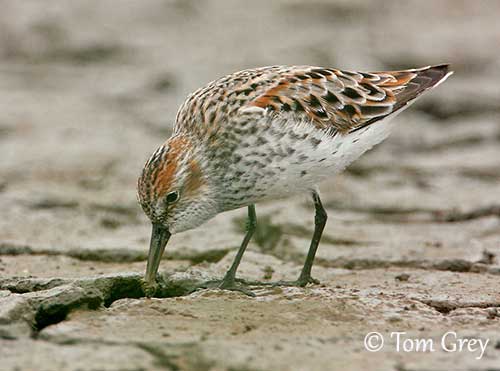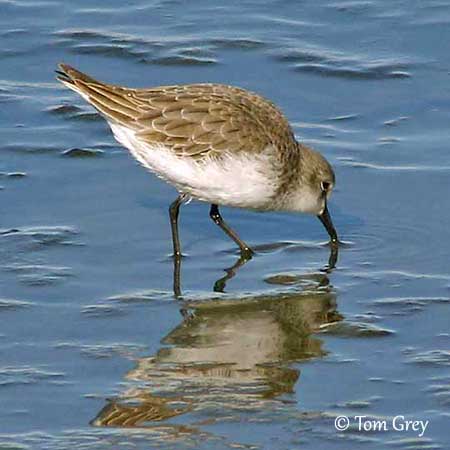
Fr: Bécasseau d’Alaska
Ang: Western Sandpiper
All: Bergstrandläufer
Esp: Correlimos de Alaska
Ita: Gambecchio dell’Alaska
Nd: Alaskastrandloper
Sd: tundrasnäppa
Photographer:
Tom Grey
Tom Grey's Bird Pictures & Tom Grey's Bird Pictures 2
Text by Nicole Bouglouan
Sources:
HANDBOOK OF THE BIRDS OF THE WORLD Vol 3 by Josep del Hoyo-Andrew Elliott-Jordi Sargatal - Lynx Edicions - ISBN: 8487334202
SHOREBIRDS by Peter Hayman, John Marchant and Tony Prater – Christopher Helm – 1986 – ISBN: 0747014035
GUIDE DES LIMICOLES de D. Taylor - Delachaux et Niestlé - ISBN : 2603014080
A GUIDE TO THE BIRDS OF MEXICO AND NORTHERN CENTRAL AMERICA by Steve N. G. Howell, Sophie Webb - Oxford University Press - ISBN: 0198540124
FIELD GUIDE TO THE BIRDS OF NORTH AMERICA - National Geographic Society - ISBN: 0792274512
All About Birds (Cornell Lab of Ornithology)
The Birds of North America online
Bird Web (Seattle Audubon Society)
What Bird-The ultimate Bird Guide (Mitchell Waite)
Western Sandpiper
Calidris mauri
Charadriiformes Order – Scolopacidae Family
INTRODUCTION:
The Western Sandpiper is a close relative of the Semipalmated Sandpiper. It breeds in the tundra of low Arctic and subarctic, usually in elevated areas. During winter and on migration, it can be seen on shorelines, sandy beaches and estuaries. The migration from Alaska and E Siberia follows both coasts of North America and northern South America in series of short flights. It feeds on insects, spiders and small crustaceans, with some variations depending on the location. It typically nests on the ground in a shallow scrape.
The Western Sandpiper is not globally threatened and the large population is currently fairly stable.
DESCRIPTION OF THE BIRD:
Biometrics:
Length: 14-17 cm
Wingspan: 28-37 cm
Weight: 18-42 g
The Western Sandpiper in breeding plumage has dark brown crown feathers with chestnut fringes, but the nape is paler chestnut. We can see a white supercilium finely streaked brown. The lores are mostly dark brown and contrast with the chestnut ear-coverts.

On the upperparts, the hindneck is greyish with heavy dark streaking. Feathers of mantle are blackish with narrow greyish and chestnut fringes. The scapulars show extensive reddish-chestnut fringes and conspicuous black subterminal crescents, whereas the tips are pale grey in fresh plumage. On the upperwing, coverts and tertials are grey-brown with paler edges. There is a narrow white wingbar formed by the pale tips of greater and inner primary coverts. Centre of rump, uppertail- coverts and tail are dark brown with pale sides, mostly white on rump sides and grey on tail sides.
The underparts are white with heavily streaked dark brown neck and breast. The chin is white. Dark streaks or chevrons extend along the flanks and reach the lateral undertail-coverts. The underwing is white.
The bill is blackish and slightly decurved. The eyes are dark brown. Legs and partially webbed feet are black, sometimes with greenish or brownish tinge.
The female has similar plumage but she is slightly larger, with longer bill, legs and wings.

Breeding female
With longer bill
The Western Sandpiper in non-breeding plumage is paler overall. The upperparts are uniformly brownish-grey with fine brown streaking on the crown. The supercilium is whitish. Sides of neck and breast are finely streaked grey, but rest of underparts is white.
The juvenile shows some rufous on upper scapulars and mostly grey on lower scapulars. The mantle is blackish with rufous and white fringes. The crown is grey with pale brown streaks.
On the white underparts, the breast is tinged orange-buff with fine streaking on the sides.
The first summer is intermediate between adult summer and winter plumages.
RANGE:
The Western Sandpiper breeds in W and N Alaska and in E Chukotskiy Peninsula. It winters along both coasts of North America and reaches Peru on the Pacific coast, and West Indies to French Guiana on Atlantic coast.

HABITAT:
The Western Sandpiper breeds on tundra slopes in dry areas with low shrub layer and nearby marshes for foraging. On migration and during winter, it frequents opens shorelines, sandy beaches and estuarine mudflats with semi-permanent tidal channels for feeding.
This species is mainly found along coasts, although small populations remain inland where they occur in coastal wetlands near lakes and ponds.
CALLS AND SONGS: SOUNDS BY XENO-CANTO
The Western Sandpiper gives soft, thin, rather high-pitched “cheep” or “kreep” higher and thinner than that of the Semipalmated Sandpiper. We can also hear shorter and hoarser calls.
The song is short, with some notes rising in pitch “twee-twee-twee” followed by a descending buzzy trill. A rapid series of high-pitched “ti-ti-ti” is given by the birds during the chases.
The alarm call during the nesting period is a series of short trills. The feeding flocks make high, excited piping and twittering.

BEHAVIOUR IN THE WILD:
The Western Sandpiper feeds mainly on insects such as flies, beetles and other species, spiders and small crustaceans on the breeding grounds.
On migration and during winter, the diet varies depending on the location. The coastal birds feed mainly on amphipods and various crustaceans, molluscs, marine worms and insects. The inland migrants feed mostly on insects and seeds.
The Western Sandpiper forages by walking in shallow water and mud. The female probes in mud with her longer bill, whereas the male picks up items from the surface of the shore.

During the breeding season, the male performs aerial displays over the territory accompanied by songs. To attract a mate, the male on the ground approaches a female in hunched posture while the tail is raised over the back. It gives repeated trilling notes. They are monogamous and territorial.
The Western Sandpiper migrates S after breeding in Alaska and E Siberia. It migrates on both coasts of North and South America, usually by series of short flights, and avoiding long overwater flights.
They travel in huge flocks and show strong fidelity to the wintering areas.
The flight is swift and direct, with rapid wingbeats.

Migrating flock
of juveniles
REPRODUCTION OF THIS SPECIES:
The laying occurs between mid-May and late June, usually earlier at southernmost breeding sites.
Following courtship displays to attract a female, the male makes several nest scrapes and the female chooses one. The nest is a shallow depression on the ground, protected by low shrub or clump of grass. There is a sparse lining of sedges, leaves and lichens. The nest site is on slightly raised or well-drained tundra.
The female lays 3-5 (usually 4) whitish to brown eggs with darker spotting. Both adults share the incubation during about three weeks. The female may sometimes depart before hatching.
The downy chicks leave the nest very soon. Both parents sometimes tend them, but the female often deserts then a few days later, and the male alone care for the young. They are able to feed themselves and they fledge 17-21 days after hatching.

PROTECTION / THREATS / STATUS:
The Western Sandpiper has very large range. The total world population size is extremely large, although a small decrease is suspected.
But the species is not globally threatened, and the Western Sandpiper is currently evaluated as Least Concern.
